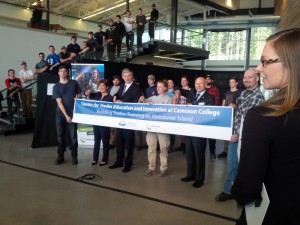Camosun College had an official ribbon-cutting ceremony on Thursday, February 25 for the new Centre for Trades Education and Innovation building, located at the Interurban campus.
The building’s construction was funded largely in part by the Ministry of Education, which contributed $29.2 million of the $30 million that has been invested in Camosun trades building upgrades (renovations are expected to be completed by the end of this year on the Jack White Building and the John Drysdale Building).
Camosun chair of Architectural Trades and Carpentry instructor Al Van Akker has been involved with the new building and is excited to see what’s happening with it at Interurban.
“It’s an exciting time for us,” he says. “Everybody is getting a little bit more room to be able to do a lot of what we are already doing, but this allows us to add some capacity as well. That should have a positive impact on things like wait times. Also, with the shop renewal, there is some new equipment that has been received. It’s been a long overdue, but much welcome, renewal of virtually all of the trades spaces.”

Minister of advanced education Andrew Wilkinson says that new buildings and renovations of existing facilities in BC are all part of the Skills for Jobs Blueprint. The Blueprint is a provincial government strategy that has earmarked a quarter of its budget to developing trades training in BC.
“We are looking forward to about 700,000 retirements in this province over the next decade, so we need to make sure that we have skilled personnel in place to replace all those people who are retiring,” says Wilkinson.
Construction on the building started in 2014, and it was built to Leadership in Energy and Environmental Design (LEED) Gold standards. The building is dedicated to training students in marine and metal trades, including welding, sheet metal, metal fabrication, nautical and shipbuilding, and repair programs. The building will also offer a mechanical trades program that will train students in heavy mechanical trades and automotive service technician skills.
“We are in a campaign to look forward to those renovations as well as purchasing equipment,” Camosun president Sherri Bell said during the ribbon-cutting ceremony. “We want our students to have a state-of-the-art experience here so that when they are working in businesses in the community, they are trained on the very best equipment with, of course, our very best faculty.”
Sara Wilson is an award-winning graduate of Camosun’s sheet metal trade program and has continued her education in the trade beyond Camosun through getting her Red Seal certification. She now works in the industry in Victoria and owes her success to the learning environment Camosun provided.
“I chose to follow a career in the trades in sheet metal. I took this leap for the chance to have a challenging and rewarding career,” says Wilson. “Camosun made this possible by offering programs, teachers, and the facilities that made my education one that would prepare me for the real work ahead. Every day in class was a chance to boost my confidence and my own abilities.”
According to Wilkinson, there is going to be a shortage of trained Canadian tradespeople over the next decade, and facilities like the Centre for Trades Education and Innovation are what the government is investing in to try to meet that demand.
“About eight out of 10 of these jobs coming up require specific postsecondary education, so we have developed a program to invest in specific training programs like this one,” says Wilkinson. “About a quarter of our budget, which is $2 billion a year, is being directed toward specific trades training programs like this and in-demand occupations, like in health.”
Now the building is just waiting for more students like Wilson to take advantage of the space and technologies that have been invested into the learning environment at Camosun.
“I think the huge influx of new and innovative technologies is what will really set Camosun apart. Students with hands-on experience, with all the latest and greatest, will have a leg up when they get into the real world,” says Wilson. “It’s changing, and companies have a need for apprentices who can run top-of-the-line equipment with the confidence that comes from already having had a chance to try them out in a safe learning environment.”
